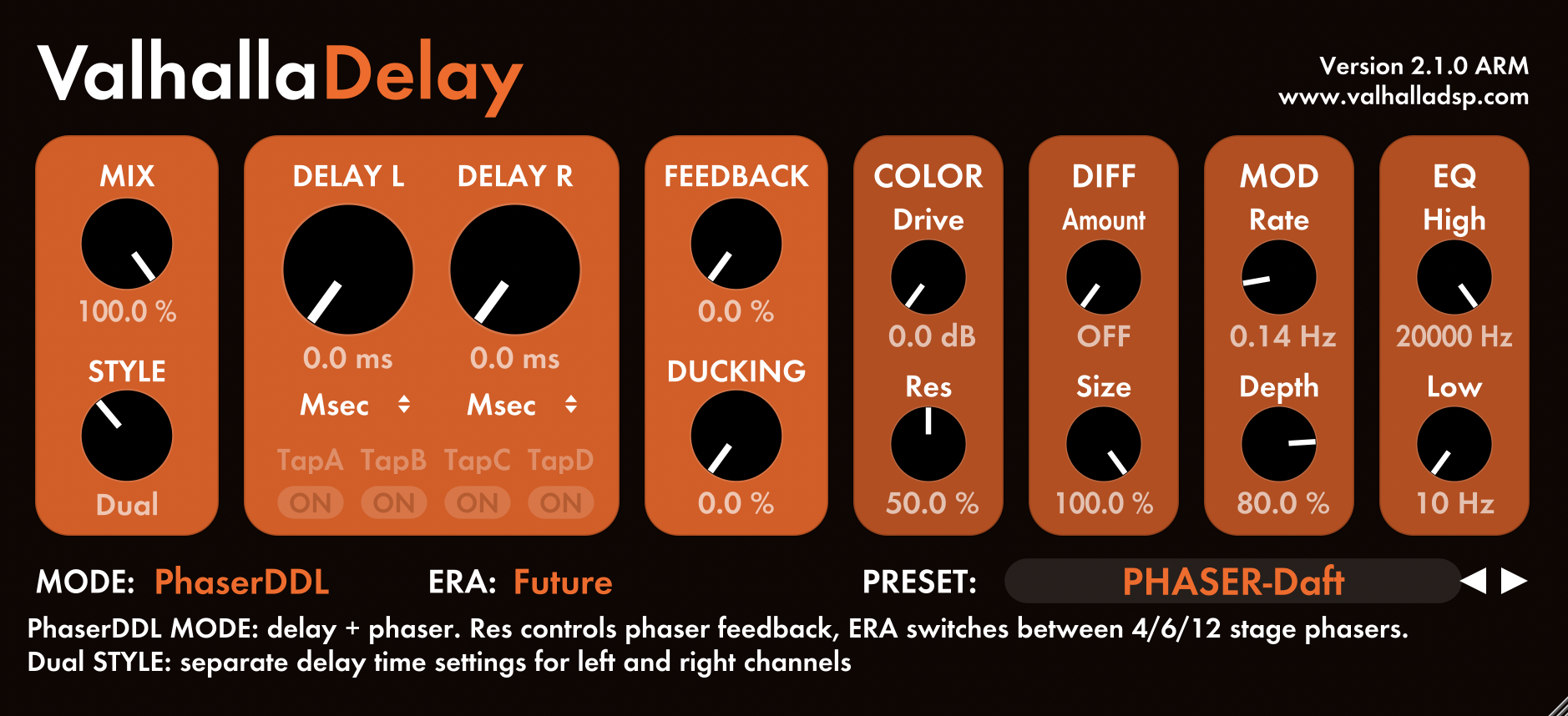The Inspiration for PhaserDDL
I have loved phase shifters, or “phasers,” for much longer than I have known what a phase shifter was. In the late 70s, phasers were everywhere, and could be heard on most of the popular hits of the day. As a little science nerd, I loved the 1980 show “Cosmos,” which prominently featured tracks by Jean-Michel Jarre that made heavy use of an Electro-Harmonix Small Stone phaser:
In my early 20s, I was a grungy long haired guitarist obsessed with loud bands, fuzz boxes, and weird sounds. I picked up my first phase shifter in 1993, the late 70s Maestro Phaser, and fell in love with that sound again. A few months later, I found a Mutron Phasor II for $12 at a garage sale. Ever since then, I’ve been picking up hardware phasers as I find them, and have a pretty decent collection at this point.

In the late 90s, I took a year-long computer music course at the University of Washington. I loved being able to explore new sounds and the canon of computer music techniques, but was also excited about taking my love of analog circuitry and extending those concepts into the digital world. By the summer of 1999, I had learned enough about DSP to create a CSound ugen, phaser1, that implemented “classic” phase shifters, as well as up to 4,999 stages of phase shifting. I managed to get a pretty decent Jarre sound out of my Pentium II, as long as I didn’t mind waiting a while for the sound to render:
Flash forward to the summer of 2020. ValhallaSupermassive had just been released, and I was in the middle of a 3 month process of updating all the Valhalla plugins for Big Sur. At some point in July, I said “I need a break,” and found myself playing more music on synthesizers. I wasn’t all that happy with the plugin phase shifting options that I owned, so decided to roll my own phaser that was tailored to the sounds that I wanted to hear!
I spent about a week coding up a basic framework, and another week analyzing some of the hardware phasers I owned, plotting out their modulation trajectory and how they responded to rate changes. A few of the cool things I found:
- My favorite phasors (Maestro Phasor, Mutron Phasor II, Schultes Compact Phaser ‘A’, MXR Phase 100) all reduce their modulation depth as the rate was increased, so things never get too wobbly at fast modulation rates. The Maestro has a cool trick in its Bob Moog-designed LFO that reduces the modulation depth at higher mod rates. The other phasers listed above use photo cells for their voltage controlled resistors, and the slew times of the photo cells results in a “natural” reduction of mod rate at higher mod depths.
- The modulation “trajectories” of the phasers are all over the map. Some are linear, some closer to exponential, and one of them is “hyper-triangular.”
- Many of the phasors have somewhat limited modulation depths. This ends up making the specific modulation trajectory kind of a moot point.
- The exponential modulation trajectories sound really nice. Not as “quirky” as some of the vintage phasers. Just more generically useful.
A few weeks ago, I was playing around with some Eurorack modules with voltage controlled wave shaping. I asked myself, “How would those sound implemented in ValhallaDelay, driven by the LFO?” Turns out they sounded HORRIBLE. At least the way I coded them. Going back to the Eurorack patches that inspired me, I got a cool sound out of a wave folder, which sounded a lot like a phase shifter. LIGHTBULB OVER HEAD TIME!!!
I went back to my phaser work from the previous summer, re-coded it as a standalone DSP block, and worked out how a phase shifter could be embedded within the feedback loop of a delay while still being stable. A standard phaser in a delay feedback loop will “blow up” when the feedback gets too high. A few hours of experimentation resulted in a highly optimized variable order phase shifting network, with an exponential sweep, that was stable in a feedback loop with feedback gains up to 100%. I set up the modulation depth to vary as an inverse function of modulation rate. The results sounded GREAT to my ears!
Once the phaser was working in ValhallaDelay, it was time to map different parameters to the existing controls. Mod Rate and Mod Depth were easy, as these parameters are already implemented in the GUI. The order of the phasers could be mapped to the ERA control (Past = 4 stages, Present = 6 stages, Future = 12 stages). I changed the label of the Age control to Res in the new phaser mode, and mapped the internal phaser feedback to that control. The Style control adjusted the modulation phase between left and right channels, as well as all the existing delay options for each delay style.
Now that everything was working, what to name the new mode? Well, it combined phase shifting with delay lines. And one of my favorite phase shifting sounds was the Ensoniq phaser that Daft Punk used all over their 2001 album, Discovery:
The Daft Punk phase shifter sound used the Phaser-DDL algorithm in the Ensoniq DP/4, which combined a stereo 12-stage phaser with a strange ping pong delay configuration. The particular Ensoniq delay arrangement didn’t make sense to me, but Phaser-DDL is a nice, descriptive name. So I dropped the hyphen, and the new delay mode was christened PhaserDDL! I didn’t go to any particular lengths to replicate whatever Ensoniq was doing in the early 90s – I can’t even find the power adaptor for my DP/2, so it hasn’t been turned on in several years. But that Daft Punk phaser sound is pretty great, so I did my best to dial in something similar for the 12-stage (Future) mode.
After 40+ years of loving the sound of phasers, and 20+ years of playing with phase shifting algorithms in the digital realm, it feels good to finally release a phase shifting algorithm to the public. I’ve really enjoyed playing with the combination of phase shifting, delays and diffusion, and hope that the PhaserDDL inspires your own creative journeys!
Want the weekly Creative blog posts delivered to your inbox every Tuesday? Sign up for the Creative Practice newsletter!





My takeaway about the Jarre sound is it was a starved Small Stone of a certain vintage and Jarre has since built a power supply to keep it in the sweet lower voltage range.
Wonderful that you keep adding algorithms.
ndkent
Phase 100 underrated, esp if vintage script logo from 70’s, same for Phase 90. lots better than modern block logo. https://www.youtube.com/watch?v=vpZ54vBrWTI pretty sure you can do the “script mod” for both, Sean! good luck!
I might have to seek out a vintage Phase 100 script logo at some point. I haven’t seen any specific mod instructions for this, but if there’s a mod to be done, I’ll try it! I gotta admit that my Phase 100 reissue, while sounding good, doesn’t sound as good as my memory of the script level box I tried in the 90s. It would be interesting to see if component differences make an impact – I don’t know if 70s Vactrols are the same as current Vactrols.
The EHX Phase 90 has a “script” button, that allows you to switch between script and block circuits. Honestly, both versions of the circuit have their uses for me. The script is a more subtle phasing effect, that sounds great at medium speeds without having an obvious sweeping sound. The block sounds nice at slow speeds, with a Big Muff feeding into it (nails some of the guitar sounds off of Bowie’s “Low”).
Time to go check out the new presets. Thank you!!
A really nice addition to a yet wonderful plugin. Thanks for your effort (and for those very interesting insight)!
There is a mod you can do to the modern EHX phasers (I’ve done it). Can’t remember the specifics, I’m sure it can be found online, but it involves just snipping one resistor to remove the pre-emphasis/de-emphasis circuitry. Results in higher noise floor but sweeter tone. 😉
Thank you so much for this brilliant update! 🙂
Hello Sean
your passion for theses olds models some of us do remember (yes i know that 80s mxr 100 so much better the 90) is always refreshing and the fact you like them and the effort you put to get that vibe is what makes your products so good.
thank you